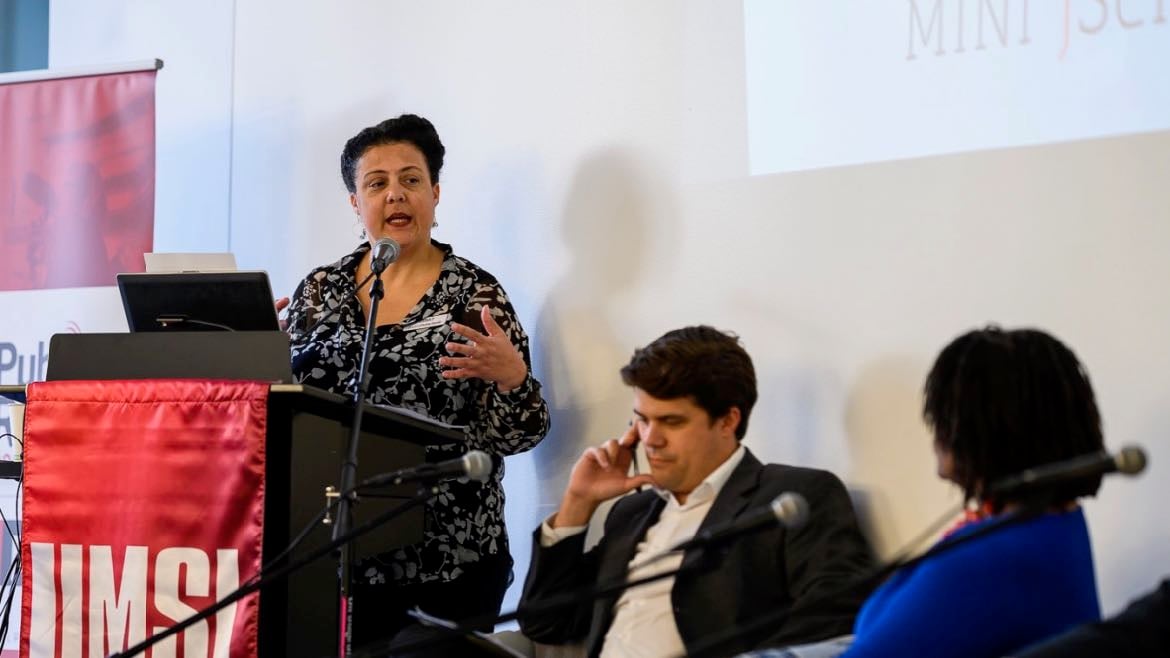‘Alma’s Way’ outreach reflects heritage for young Latino viewers in rural Tennessee and beyond

Courtesy WCTE
Putman uses branded "Alma's Way" materials with pre-K students.
Working from drawings by pre-kindergarten students at Jere Whitson Elementary School in Cookeville, Tenn., Cindy Putman of WCTE is preparing for the unveiling of a mural-painting project inspired by Alma’s Way, the new PBS Kids series from Fred Rogers Productions.
The mural, which features hand-painted versions of the students’ drawings, will go on display in the school’s entryway Nov. 23, weather permitting.
Putman is WCTE’s Ready To Learn champion. She also serves as the academic-social interventionist for Putnam County School System, which includes Jere Whitson. During weekly visits to two pre-K classrooms at the school, Putman has been screening clips from Alma’s Way and using branded learning materials that reinforce the series’ social and emotional learning curriculum. She’s also been working with students on the mural, which incorporates their drawings of where they live.
Alma’s Way targets children ages 4–6 and models problem-solving and creative thinking skills. Alma Rivera, the star of the animated series, is a proud and confident Puerto Rican girl who lives in the Bronx, N.Y. The series was created by Sonia Manzano, the actor who portrayed one of the first Latina characters on national television — Maria on Sesame Street.
Each episode is structured so that Alma realizes something needs to change but isn’t sure what to do. “She always says, ‘I got to think about this,’” said FRP’s Ellen Doherty, series EP along with Manzano.
These think-through moments allow Alma to reflect on what happened, consider other outcomes and imagine what might happen next.
“This is important, for kids to have Alma as this role model for confident thinking and self-advocacy,” Doherty said. At ages 4–6, children start to recognize there are other ways to do things. “There might be a little bit of doubt creeping in about what [and] how to do something.”
Alma eventually says “I know what to do,” Doherty said. Most of the time, that involves talking with a family member or friend to agree on a solution.
Whenever Alma makes a mistake and adjusts, she shows children how to solve problems, Putman said. The series also represents Latino family life, cuisine and cultural traditions.
During the episode “Bomba or Baseball?” Alma has to choose whether to follow through on a commitment she made to her Uncle Nestor or to go to a baseball game with her grandfather.
Alma wants to go to the game but knows she needs to honor her commitment to attend a bomba dance that her uncle is organizing. She learns and practices the traditional Puerto Rican dance, and is happy to learn on the day of the game that she is performing at the baseball stadium.
FRP has been working with stations on promotion and educational outreach, said President Paul Siefken. Promotional resources and learning materials support the entire series, but some focus on specific episodes, he said. CPB provided a $2.7 million grant that funds FRP’s work on Alma’s Way, including production, promotion and learning materials that support its curriculum.
Much of the station activity around the program to date has been outside classrooms.
Kansas City PBS produced a virtual workshop tied to Alma’s Way for children during the week of the show’s Oct. 4 premiere. The outreach team is working to incorporate the series into a kindergarten-readiness program for children in high-need neighborhoods, said KCPT Director of Education Gary Brock.
The WNET Group in New York City partnered with Homes for the Homeless to host three screening events where children received branded coloring pages and paint sets, said Eleanor Jánszky, early learning specialist.
The series resonates with WNET’s young viewers, she said. Latino children see themselves and their culture represented in the stories, and all children who live in the region recognize the sights and sounds of their city.
WFSU in Tallahassee, Fla., has introduced the show to students via Zoom events in which families and child-care providers screen an episode and complete an activity, said Education and Engagement Manager Tasha Weinstein.

In central Tennessee, Putman created the mural-painting project to engage students and their families with the new show. The episode “Alma the Artist,” in which Alma and her friends paint a mural outside of a bodega in the Bronx, was her inspiration.
The Putnam County Schools are predominantly white, but nearly 16% of students are Latino or Hispanic, Putman said. Many of these students do not speak English and have recently migrated to the U.S. At Jere Whitson, 70% of students are Latino or Hispanic, and most receive free or reduced lunches.
Putman works in two English to Speakers of Other Languages classrooms and has witnessed how the students respond to the series. Alma helps them feel comfortable in their skin, she said.
“The first time I put Alma’s Way on — to see the expressions on their faces, that they saw someone that looked like them, that they saw someone that did not have a heavy Southern accent like all of us have,” Putman said. “They saw different aspects of culture and different aspects of family relationships that looked very much like what they are experiencing.”
The mural at Jere Whitson will be displayed under the school’s covered entrance, where parents and family members pick up children, Putman said. She hopes that the murals create a sense of pride and achievement.
“When the families come … they will be able to see a reflection of their neighborhood,” Putman said. “What we really want to do is help kids understand that they have something important to contribute to their school.”
“We can teach all day long, but if we do not relate it to a child in the world in which they live, we are never going to make those connections,” Putman said. “And those connections are what build brainpower. I think it’s so important that Alma’s Way is providing educators across the country and parents ways to help their children make those connections.”
Corrections: An earlier version of this article referred to Ellen Doherty of Fred Rogers Productions as co-EP of Alma’s Way. She is series EP, along with Sonia Manzano. Also, due to an editing error, a photo caption incorrectly said that El Centro Academy for Children is in Kansas City, Mo. It is in Kansas City, Kan.







